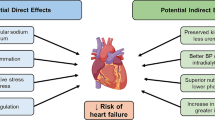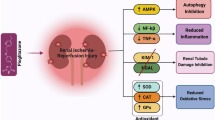Abstract
Diabetic nephropathy (DN) is a condition that leads to end-stage chronic kidney disease characterized by inflammation and a deficiency of nitric oxide (NO). Cannabinoid receptor (CB2) activation by specific agonist reduces nuclear factor kappa beta (NF-κβ) expression. Beta caryophyllene (BCP), a natural CB2 receptor activator, protects kidney function in several diseases. l-Arginine (LA) modulates several physiological processes by donating nitric oxide (NO). Hence, we tested a novel BCP-LA combination to treat DN and investigated its molecular mechanisms. BCP, LA, and combinations of both were evaluated in LPS-induced RAW 264.7 macrophage inflammation as well as in streptozotocin (55 mg/kg)-induced diabetes in SD rats. Diabetic rats were administered 200 mg/kg of BCP, 100 mg/kg of LA, and combination of both orally for 28 days. Biochemical markers and inflammatory cytokines were assessed in plasma; also, kidney tissue was examined for renal oxidative stress injury, NF-κβ expression, and histology. After 28 days of treatment, BCP and LA combination significantly lowered plasma glucose levels than the disease control group. BCP and LA also normalized renal markers and oxidative stress of diabetic rats. Plasma and RAW macrophage cell lines showed reduced levels of IL-6 and TNF-α (P < 0.001). Histopathological evaluations revealed that BCP and LA together decreased renal fibrosis and collagen deposition also improved nephrotic indices. Meanwhile, the effect of BCP and LA together significantly reduced the NF-κβ (P < 0.01) against diabetic rats. These results indicate that the innovative regimen BCP with LA may be a therapeutic treatment for DN, as it protects kidney tissue from diabetes via NF-κβ inhibition.
Graphical abstract









Similar content being viewed by others
Data availability
Data available on request from the corresponding author.
References
Blake K (2021) Beta-caryophyllene: a review of current research. Altern Complement Ther 27(5):222–226. https://doi.org/10.1089/act.2021.29349.kbl
Cheng H, Harris R (2014) Renal endothelial dysfunction in diabetic nephropathy. Cardiovasc Hematol Disord Drug Targets 14(1):22–33. https://doi.org/10.2174/1871529x14666140401110841
Chua JT, Argueta DA, Dipatrizio NV, Kovesdy CP, Vaziri ND, Kalantar-Zadeh K, Moradi H (2019) Endocannabinoid system and the kidneys: from renal physiology to injury and disease. Cannabis Cannabinoid Res 4(1):10. https://doi.org/10.1089/CAN.2018.0060
Claybaugh T, Decker S, McCall K, Slyvka Y, Steimle J, Wood A, Schaefer M, Thuma J, Inman S (2014) L-Arginine supplementation in type II diabetic rats preserves renal function and improves insulin sensitivity by altering the nitric oxide pathway. Int J Endocrinol 171546:1–7. https://doi.org/10.1155/2014/171546
Donadelli M, Dando I, Zaniboni T, Costanzo C, DallaPozza E, Scupoli MT, Scarpa A, Zappavigna S, Marra M, Abbruzzese A, Bifulco M, Caraglia M, Palmieri M (2011) Gemcitabine/cannabinoid combination triggers autophagy in pancreatic cancer cells through a ROS-mediated mechanism. Cell Death Dis 2(4):e152. https://doi.org/10.1038/cddis.2011.36
Ellman GL (1959) Tissue sulfhydryl groups. Archives of Biochemistry and Biophysics 82(1): 70–77
Gandhi C, Zalawadia R, Balaraman R (2009) Nebivolol reduces experimentally induced warm renal ischemia reperfusion injury in rats. Ren Fail 30(9):921–930. https://doi.org/10.1080/08860220802353900
Gao Y, Jiang W, Dong C, Li C, Fu X, Min L, Tian J, ** H, Shen J (2012) Anti-inflammatory effects of sophocarpine in LPS-induced RAW 264.7 cells via NF-κB and MAPKs signaling pathways. Toxicol In Vitro 26(1):1–6. https://doi.org/10.1016/j.tiv.2011.09.019
Hernandez LF, Eguchi N, Whaley D, Alexander M, Tantisattamo E, Ichii H (2022) Anti-oxidative therapy in diabetic nephropathy. In Frontiers in bioscience (scholar edition) (Vol 14, Issue 2, p 14). Front Biosci (Schol Ed). https://doi.org/10.31083/j.fbs1402014
Hojs NV, Bevc S, Ekart R, Hojs R (2020) Oxidative stress markers in chronic kidney disease with emphasis on diabetic nephropathy. In Antioxidants (Vol 9, Issue 10, pp 1–22). Multidisciplinary Digital Publishing Institute. https://doi.org/10.3390/antiox9100925
Hoogeveen EK (2022) The epidemiology of diabetic kidney disease. Kidney Dialysis 2(3):433–442. https://doi.org/10.3390/kidneydial2030038
Hryciw DH, Mcainch AJ (2016) Cannabinoid receptors in the kidney. In Current opinion in nephrology and hypertension (Vol 25, Issue 5, pp 459–464). Curr Opin Nephrol Hypertens. https://doi.org/10.1097/MNH.0000000000000249
Hryhorowicz S, Kaczmarek-Ryś M, Zielińska A, Scott RJ, Słomski R, Pławski A (2021) Endocannabinoid system as a promising therapeutic target in inflammatory bowel disease – a systematic review. Front Immunol 12. https://doi.org/10.3389/FIMMU.2021.790803
International Diabetes Federation (2021) IDF Diabetes Atlas 2021. In International Diabetes Federation. https://diabetesatlas.org/atlas/tenth-edition/
Katsuyama K, Shichiri M, Marumo F, Hirata Y (1998) NO inhibits cytokine-induced iNOS expression and NF-κB activation by interfering with phosphorylation and degradation of IκB-α. Arterioscler Thromb Vasc Biol 18(11):1796–1802. https://doi.org/10.1161/01.ATV.18.11.1796
Krause MS, Mcclenaghan NH, Flatt PR, de Bittencourt PIH, Murphy C, Newsholme P (2011) L-Arginine is essential for pancreatic β-cell functional integrity, metabolism and defense from inflammatory challenge. J Endocrinol 211(1):87–97. https://doi.org/10.1530/JOE-11-0236
Kumawat VS, Kaur G (2020) Insulinotropic and antidiabetic effects of β-caryophyllene with l-arginine in type 2 diabetic rats. J Food Biochem 44(4):e13156. https://doi.org/10.1111/jfbc.13156
Kumawat VS, Kaur G (2022) Cannabinoid 2 receptor agonist and L-arginine combination attenuates diabetic cardiomyopathy in rats via NF-Œb inhibition. Can J Physiol Pharmacol 100(3):259–271. https://doi.org/10.1139/cjpp-2021-0046
Lück H (1965) Catalase. In Methods of enzymatic analysis (pp 885–894). Elsevier. https://doi.org/10.1016/B978-0-12-395630-9.50158-4
Ma B, Zhu Z, Zhang J, Ren C, Zhang Q (2020) Aucubin alleviates diabetic nephropathy by inhibiting NF-κB activation and inducing SIRT1/SIRT3-FOXO3a signaling pathway in high-fat diet/streptozotocin-induced diabetic mice. J Funct Foods 64:103702. https://doi.org/10.1016/j.jff.2019.103702
Makary S, Abdo M, Hassan WA, Tawfik MK (2019) Angiotensin blockade attenuates diabetic nephropathy in hypogonadal adult male rats. Can J Physiol Pharmacol 97(8):708–720. https://doi.org/10.1139/cjpp-2018-0572
McRae MP (2016) Therapeutic benefits of L-arginine: an umbrella review of meta-analyses. In Journal of Chiropractic Medicine (Vol 15, Issue 3, pp 184–189). Elsevier. https://doi.org/10.1016/j.jcm.2016.06.002
Nauck MA, Wefers J, Meier JJ (2021) Treatment of type 2 diabetes: challenges, hopes, and anticipated successes. In The Lancet Diabetes and Endocrinology (Vol 9, Issue 8, pp 525–544). Elsevier. https://doi.org/10.1016/S2213-8587(21)00113-3
Ohkawa H, Ohishi N, Yagi K (1979) Assay for lipid peroxides in animal tissues by thiobarbituric acid reaction. Anal Biochem 95(2):351–358. https://doi.org/10.1016/0003-2697(79)90738-3
Oza MJ, Kulkarni YA (2019) Formononetin attenuates kidney damage in type 2 diabetic rats. Life Sci 219:109–121. https://doi.org/10.1016/j.lfs.2019.01.013
Paoletti F, Aldinucci D, Mocali A, Caparrini A (1986) A sensitive spectrophotometric method for the determination of superoxide dismutase activity in tissue extracts. Anal Biochem 154(2):536–541. https://doi.org/10.1016/0003-2697(86)90026-6
Pelle MC, Provenzano M, Busutti M, Porcu CV, Zaffina I, Stanga L, Arturi F (2022) Up-date on diabetic nephropathy. In Life (Vol 12, Issue 8). Life (Basel). https://doi.org/10.3390/life12081202
Rayego-Mateos S, Morgado-Pascual JL, Opazo-Ríos L, Guerrero-Hue M, García-Caballero C, Vázquez-Carballo C, Mas S, Sanz AB, Herencia C, Mezzano S, Gómez-Guerrero C, Moreno JA, Egido J (2020) Pathogenic pathways and therapeutic approaches targeting inflammation in diabetic nephropathy. In International Journal of Molecular Sciences (Vol 21, Issue 11, p 3798). Multidisciplinary Digital Publishing Institute. https://doi.org/10.3390/ijms21113798
Refaat B, El-Boshy M (2022) Protective antioxidative and anti-inflammatory actions of β-caryophyllene against sulfasalazine-induced nephrotoxicity in rat. Exp Biol Med 247(8):691–699. https://doi.org/10.1177/15353702211073804
Soetikno V, Sari FR, Veeraveedu PT, Thandavarayan RA, Harima M, Sukumaran V, Lakshmanan AP, Suzuki K, Kawachi H, Watanabe K (2011) Curcumin ameliorates macrophage infiltration by inhibiting NF-B activation and proinflammatory cytokines in streptozotocin induced-diabetic nephropathy. Nutr Metab 8(1):1–11. https://doi.org/10.1186/1743-7075-8-35
Suryavanshi SV, Kulkarni YA (2017) NF-κβ: a potential target in the management of vascular complications of diabetes. In Frontiers in Pharmacology (Vol 8, Issue NOV, p 798). Frontiers Media SA. https://doi.org/10.3389/fphar.2017.00798
Tesch GH, Allen TJ (2007) Rodent models of streptozotocin-induced diabetic nephropathy (methods in renal research). Nephrology 12(3):261–266. https://doi.org/10.1111/j.1440-1797.2007.00796.x
Xu X, Yan J (2021) β-Caryophyllene may attenuate hyperoxaluria-induced kidney dysfunction in rats by regulating stress marker KIM-1/MCP-1 and NF-κB signaling pathway. J Biochem Mol Toxicol 35(11):e22891. https://doi.org/10.1002/jbt.22891
Yamaguchi M, Levy R (2019) The combination of catechin, baicalin and β-caryophyllene potentially suppresses the production of inflammatory cytokines in mouse macrophages in vitro. Exp Ther Med 17(5):4312. https://doi.org/10.3892/etm.2019.7452
Zhai XT, Zhang ZY, Jiang CH, Chen JQ, Ye JQ, Jia XB, Yang Y, Ni Q, Wang SX, Song J, Zhu FX (2016) Nauclea officinalis inhibits inflammation in LPS-mediated RAW 264.7 macrophages by suppressing the NF-κB signaling pathway. J Ethnopharmacol 183:159–165. https://doi.org/10.1016/j.jep.2016.01.018
Zhou S, Ling X, Meng P, Liang Y, Shen K, Wu Q, Zhang Y, Chen Q, Chen S, Liu Y, Zhou L (2021) Cannabinoid receptor 2 plays a central role in renal tubular mitochondrial dysfunction and kidney ageing. J Cell Mol Med 25(18):8957–8972. https://doi.org/10.1111/jcmm.16857
Zoja C, **naris C, Macconi D (2020) Diabetic nephropathy: novel molecular mechanisms and therapeutic targets. In Frontiers in Pharmacology (Vol 11, p 2139). Frontiers Media S.A. https://doi.org/10.3389/fphar.2020.586892
Author information
Authors and Affiliations
Contributions
The authors confirm their contribution to the paper as follows: 1. VSK - Performed research, analysed the data interpretation results and draft the manuscript preparation. 2. GK -Designed the research protocol, and read, and approved the manuscript. Both authors reviewed the results and approved the final version of the manuscript. The authors declare that all data were generated in-house and that no paper mill was used.
Corresponding author
Ethics declarations
Ethical approval
The animals were treated in accordance with the Guide for the Care and Use of Laboratory Animals (eight edition, National Academies Press). This research manuscript reporting adheres to the ARRIVE guidelines. The research protocol was approved by the Institutional Animal Ethics Committee and procedures were performed as per the CPCSEA (Committee for the Purpose of Control and Supervision of Experiments on Animals) guidelines, Govt. of India (Registration no: CPCSEA/ IAEC/ P-38/2019).
Consent to participate
Not applicable.
Consent for publication
The authors confirm their agreement for publication.
Competing interests
The authors declare no competing interests.
Additional information
Publisher's note
Springer Nature remains neutral with regard to jurisdictional claims in published maps and institutional affiliations.
Rights and permissions
Springer Nature or its licensor (e.g. a society or other partner) holds exclusive rights to this article under a publishing agreement with the author(s) or other rightsholder(s); author self-archiving of the accepted manuscript version of this article is solely governed by the terms of such publishing agreement and applicable law.
About this article
Cite this article
Kumawat, V.S., Kaur, G. Cannabinoid receptor 2 (CB2) agonists and l-arginine ameliorate diabetic nephropathy in rats by suppressing inflammation and fibrosis through NF-κβ pathway. Naunyn-Schmiedeberg's Arch Pharmacol 397, 381–393 (2024). https://doi.org/10.1007/s00210-023-02597-0
Received:
Accepted:
Published:
Issue Date:
DOI: https://doi.org/10.1007/s00210-023-02597-0




